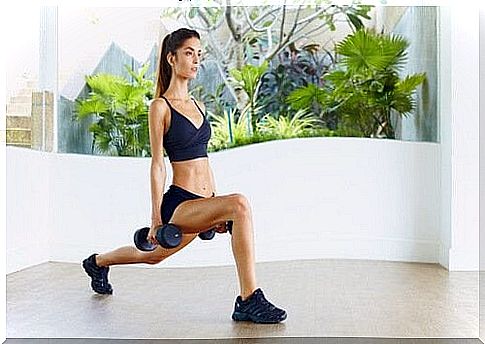What Is Best When You Train: More Weight Or More Repetitions?

We have to choose one alternative or the other depending on our goals. Since we have to use different routines to lose weight or gain muscle in certain areas. Anyone who goes to the gym or exercises at home has certainly at some point asked the question: What is best when you exercise? More weight or more repetitions?
It all depends on what our goals are. To know more, continue reading this article.
Should I lift more weight or do more repetitions?

The really big question when it comes to training is how to best get stronger muscles or how to lose weight faster.
- There are different ways to train that can help us achieve different goals.
- Which type of training you choose depends entirely on what you want to achieve.
It is important to always challenge ourselves. If we always lift the same weight, do the same number of repetitions or run at the same speed, the body gets used to it and reaches a “low” threshold.
That way, we tell ourselves that we have reached our goal and that we do not need to make any more effort. The result or consequence of this habit just does not create any change or improvement.
Although the body is more and more resistant to exercise (and this is also good news), we can not remain “locked in” to the same routine. Because it’s very boring too.
Variations are necessary because they allow us to improve and reach our goals or at least get closer to them.
If we want more muscle mass, we need to lift more and more weight than we are used to.
It does not matter how many repetitions we make, but rather the number of kilos that we can add to the bar or to the machine in question. Progress is very important, given that the body gets used to it.
But be careful, because it should not be done to push yourself, as it can lead to muscle and joint injuries that, in addition to being painful, move us away from our goals.
It is not advisable to add a lot of weight at the same time, but to proceed slowly.
More repetitions = more progress?
As for repetitions, we may have “permission” to change them to our liking and even reduce the amount if we pay more attention.
The problem is that soon after, the body gets comfortable again (reaches a ceiling), and if we do not introduce a change, we do not improve or move forward.
Instead of increasing the load, it is advisable to do several repetitions with the same weight. When this weight and these repetitions no longer pose a challenge to you, you need to change one or the other variable.
Thanks to the repetitions you will become stronger because you will develop the muscles and the organism will be more resistant to fatigue. In addition, you can burn more fat and calories.
The increase in repetitions does not always have to go hand in hand with an increase in weight; Instead, you can switch out the changes.
A good technique for lifting weights consists of fewer loads, but more repetitions. Thus, we focus on the movement and avoid injuries caused by excessive weight without prior preparation.
It is not recommended to exceed 16 repetitions when lifting weights. If it seems low, then it is because you need to increase the weight.
To be able to create profession from step to step, it is important to change your routines. As you can lift more weight you can increase the repetitions and vice versa.
To gain strength: more weight or more repetitions?

Hypertrophy (multiple muscles) is one of the primary goals in the world of fitness.
For this we need to produce muscle damage, which leads to protein synthesis and the building up of muscle fibers (during the recovery process).
- Three factors affect this process: mechanical stress, metabolic stress and muscle damage.
- To develop muscle mass, we need to perform between 3 and 5 sets of up to 12 repetitions with breaks of 1 to 3 minutes.
Strength and resistance are the other two pillars that athletes aim for.
The type of weight series depends on what we want to achieve.
- To build strength, between 4 and 8 sets of 1 to 3 repetitions with the maximum capacity that we can lift are recommended.
- On the other hand, to build resistance, loads must be lowered and repetitions increased (between 12 and 16).
High-load sessions increase strength, but this type of training can have consequences and risks. For example, it causes damage or negative adjustments.
Low loads are less “harmful”, but the results are less.
As long as they are done with planning and guidance, both of the two methods can be healthy.
To burn fat: more weight or more repetitions?

This is another common issue in the gym.
Although there are many myths related to this topic, the truth is that training with the right weights and repetitions and increasing them every two weeks (according to our progress) is going in the right direction.
Many people relate the burning of calories with aerobic exercise (for example, the treadmill or the stationary bike) and not with a session of weight lifting.
The reality is that both can complement each other to achieve your weight loss goals.
Nor is it true that we want to reduce fat by doing more repetitions. It all depends on the intensity that we use for the training.
High loads and few repetitions result in more muscle mass and thus less fat.
If we are trying to burn calories and gain muscle, then it is better to do repetitions with high weight rather than low weight.
But if your only goal is to lose weight, then several sets of low loads are recommended.









